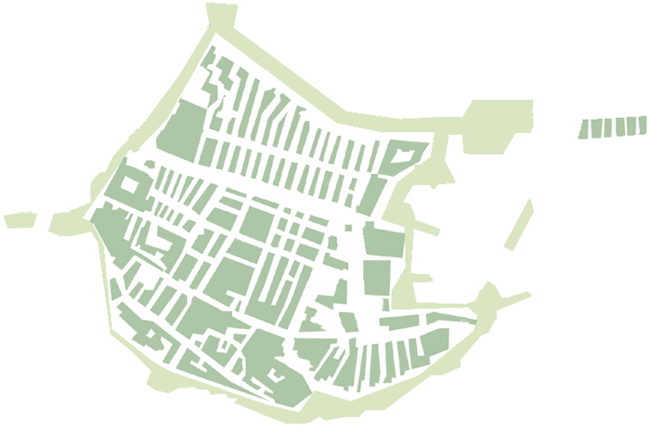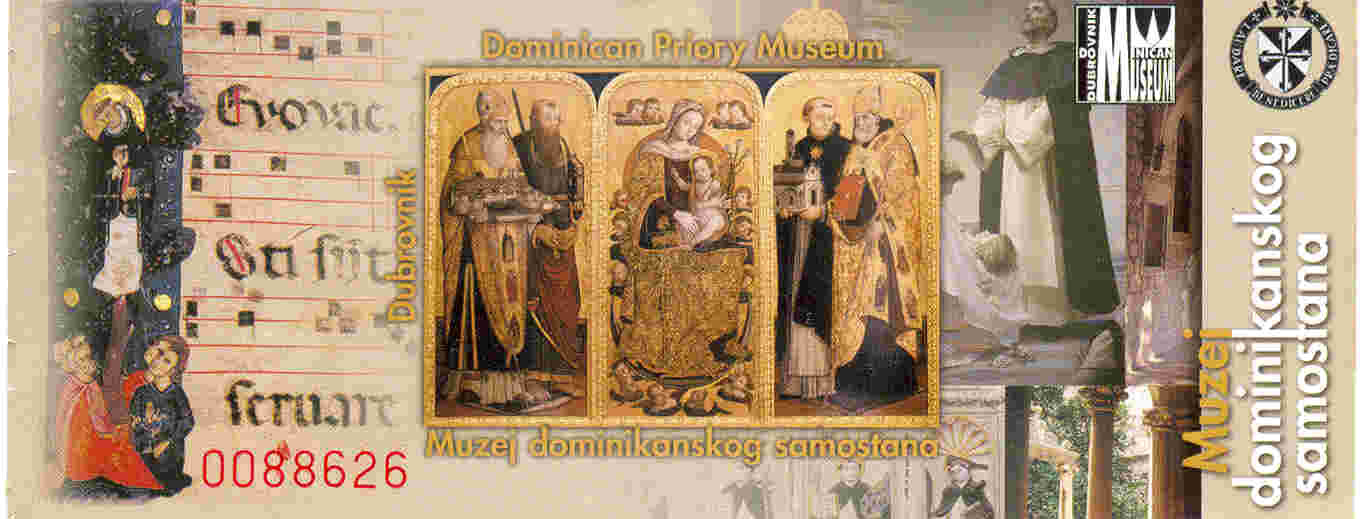Tour of Dubrovnik's Sites
I spent almost two days touring this southern Dalmatian city. Because my wandering was in no coherent order, I have arranged my description based on the map below, which is courtesy of Dubrovnik Tourist Bureau. Please click on an attraction to be directed to its information.

I entered the city from the west. On this side of the city walls, there are a number of small cafés, as well as a taxi stand. The latter is handy, especially if the hotel is located 6 kilometers from the old town. The tour buses also park near this gate, so if one enjoys older German women, this is the spot to "pick them up"!
The
Pile Gate is the entrance to the old city from
the western suburbs. One enters the gate over a stone bridge, which covers
the moat that now is filled with fruit trees. Legend states that the
bridge was raised each night and the doors to the city were locked. The
key then was given to the prince, who would keep it until the next morning.
Like most gates in European medieval towns, there is a statue of a saint over the entrance. The saint over this entrance is Saint Blaise, the city's patron saint. According to local legend, Saint Blaise appeared in a local priest's dream in 791 CE to warn of an impending attack by the Venetian Republic. This premonition provided enough warning for the city to marshal its military resources and defend itself. The city was saved, and Saint Blaise became the city's patron saint.
Just inside the doorway is a map of the sites damaged during the recent war of independence. This map provides locations for buildings that were damaged or completely destroyed. It is a chilling reminder that this city found itself under attack just eleven years ago.
At the end of the ramp that descends down to Placa, the visitor can find the entrance to the city walls tour. I recommend that visitors complete this tour in the morning to avoid the hot afternoon sun.
Just inside the Pile Gate is the Poljana Paka Miličevića, the square at the western end of Placa. The square contains a number of important buildings and structures. In the center of the square is the Large Onofrio Fountain. Constructed in 1438 by Onofrio de la Cave, the fountain was part of the city's waterworks, which provided Dubrovnik with fresh water from the Rijeka Dubrovačka nearly 12 kilometers away. This project provided the city with a fresh water source, a sign of prosperity and wealth in medieval Europe. Before entering the city, all visitors had to wash themselves in the fountain; it was thought that this practice would cleanse the foreigners of the plague. Many of the fountain's ornate decorations were destroyed in the 1667 earthquake, so its splendor is diminished somewhat. But it still is considered one of Dubrovnik's most important landmarks and is a congregating point for residents and tourists alike.
|
|
|
| The Large Onofrio Fountain. Notice the carvings at mid-level; water spouts from the mouths of these faces. | An aerial view of the Large Onofrio Fountain. |
In addition to the fountain, there are three buildings of religious purpose on the square. To the south is the Convent of Saint Claire. Built in the 13th c. CE, it was one of Dubrovnik's most famous homes for nuns. In the 15th c. CE, one of the wings was converted into an orphanage for abandoned and illegitimate children. When the French took control of the city, the convent was closed and the building converted into a magazine, then stables. It is now home to offices and stores, while its courtyard hosts a fruit tree-shaded café. The cloisters are quite beautiful and provide ample shade from the summer sun.
To the north of the fountain are the Crkva Sveti Spasa and the Franjevački samostan. The former is a small votive church built in 1520; the city's leaders provided it as appreciation for salvation from the earthquake that struck the area that year. It withstood the catastrophic earthquake 147 years later, and now provides a venue for classical music concerts. Behind the church is the Franciscan monastery. Built in the 14th c. CE in the Romanesque style, the monastery once boosted one of the best libraries in the Christian world. Most of the original collection was destroyed in a fire caused by the 1667 earthquake. The collection was started again in the 19th c. CE by Inočentije Čulić, who collected books and manuscripts from monasteries closed during the French occupation. The monastery also was known as a center of medicine, housing the city's first pharmacy in 1317. The main altar is impressive, with its white, red and green marble decorations and paintings.
|
|
|
| Courtyard of the Convent of Saint Blaise. The café tables are set for lunch service. | To the left is the votive Crkva Sveti Spasa with the Franjevački samostan extending to the right. |
The city's main street is Stradun, also known as Placa. This street started as the canal that separated the Roman Ragusa from the Slavic Dubrovnik, but, eventually, was paved to join the two settlements. This marble-covered street now hosts a number of cafés and stores catering to tourists. It also serves as the center of activity for the old town.
|
|
|
| Looking east down Stradun | The belltower at the east end of Stradun |
At the eastern end of the Stradun is the old town's other locus of historical buildings, which center on the Lua Square. On the northern side of the square is the Sponza Palace. Constructed commenced in 1516; the architect, Paskoje Miličević, combined late Gothic and Renaissance styles to provide a true "Dubrovnik" style. When completed, part of the building was used as the city-state's mint. It evolved into a center for Dubrovnik's learned community, a function it continues to serve today. It hosts the archives that chronicle the history of Dubrovnik, under the local name of Dravni Archiv u Dubrovniku. During my visit, there was an exhibit commemorating the Dubrovnik citizens that lost their lives during the recent war of independence.
In the square is a small fountain, constructed during Onofrio's 15th c. CE waterworks project. This a smaller version of the fountain on the west side of the old town.
Known locally as Crkva Sveti Vlaha, the first church dedicated to Saint Blaise, the city's patron saint. Constructed in the Romanesque style, the first church on this plot was destroyed in the 1667 earthquake. A second church was built, but later razed on 24 May 1706 during a fire. This current building was constructed in 18th c. CE and modeled after Venice's church dedicated to Saint Mauritius. The top of the church's façade is crowned with a statue of Saint Blaise. In his left hand, he is holding model of his patron city before it was destroyed by the 17th c. CE earthquake. This statue is the only item that survived a fire that razed the second church. It was housed temporarily in the church dedicated to Saint Nicholas, but moved back here when the new church was completed in 1715.
|
|
|
| The ornate façade of Crkva Sveti Vlaha | The statue of Sveti Vlaha (Saint Blaise) that survived the fire of May, 1705 |
Southeast of Crkva Sveti Vlaha is the Rector's Palace. Built in the 15th c. CE, the building was the resident for the city-state's knez, or rector. During his one-month tenure, the knez was sequestered in the palace and could only leave for state functions. And southwest of the palace is the city's main cathedral - Stolna Crkva Velike Gospe. Three churches have stood on this site: first a Byzantine structure built in the 7th c. CE, followed by a Romanesque structure constructed in the 12th c. CE, and the current Baroque-style church constructed in the early 18th c. CE. Legend states that the English king, Richard the Lionhearted, constructed the second church while he was shipwrecked on the nearby island of Lokrum; this church was destroyed in the 1667 earthquake. The current church was designed by Buffalini and is painted in a stark white color. There are a number of altars in the church, including one dedicated to St John Nepomuk.
During my visit, the church was preparing for a Papal visit, which occurred two weeks later. He was coming to Dubrovnik to beautify a local nun, Marije Propetog Petković.
|
|
|
| The façade of the city's main cathedral | The cathedral's dome |
|
|
|
| The church's main altar. Behind the altar is The Assumption, by Titian. It was bought by the Brotherhood of the Lazarini, a commoner association in Dubrovnik. | A side altar with a painting of the Madonna and Child, located in the northwest corner. |
There are two Jesuit institutions southwest of the main cathedral. Down a set of Baroque stairs is the Crkva Sveti Ignacija, dedicated to the patron saint of the Society of Jesus (Jesuits). Started in 1699 and completed and consecrated in 1725, the church is constructed in the same Baroque style as the main cathedral. Designed by Roman architect Andrea Pozzo, the church is modeled after Rome's Saint Ignatius Church. The sanctuary was painted by the Silician Gaetano Garzia. The paintings on the ceiling and dome represent the glory of Saint Ignatius, while the painting behind the main altar shows the saint holding the Society's Book of Rules. The four women that surround him represent the four continents on which the Jesuits were operating. Also in the church is a grotto that was constructed in 1855. Modeled after the grotto of Our Lady of Lourdes, it claims to be one of the oldest in Europe. Other than a few tourists milling around the sanctuary, there was no activity in the building.
The second Jesuit building is the Collegium Ragusinum, which had been the Jesuit's center of learning in Dubrovnik. When the Jesuits were expelled by the French in the early 19th c. CE, the college was converted into a secular institution.
|
|
|
| The façade of the Crkva Sveti Ignacija. The church's exterior was undergoing renovation during my visit. | The main altar, showing Saint Ignatius holding the Book of Rules. Unfortunately, the lighting is too poor to see the brilliance of the altar's art. |
In the northeast corner is the former Dominican monastery, which now hosts a museum of religious art - Muzej Dominikanskog Samostana. The monastery is constructed in the same Gothic-Renaissance style as the Sponza Palace. The interior has beautiful cloisters, constructed by local artisans based on the design of Florentine architect Massa di Bartolomeo.
 |
|
| Entrance ticket to the Dominican monastery | The arches of the cloisters |
|
|
|
| The interior the Dominican monastery's church. The altarpiece was designed by local Vlaho Bukovac. | The monastery's bell tower, which looms over the inner courtyard. |
Return to Dubrovnik
Main Page or Croatia Main Page